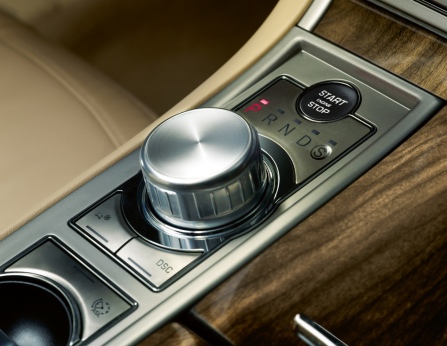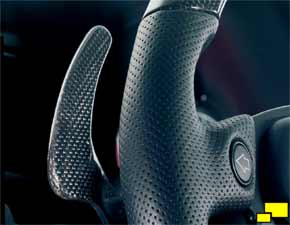Automatic gear knob found in a Jaguar XF.
Back in high school I made a really a dumb statement in a conversation with a fellow student. The conversation was about which would I prefer, manual or automatic. I said automatic, because the strain of a manual gearbox wasn't worth it, to me it was a relic in the automobile [in my defense this was roughly a year before the car bug bit]. If I could go back in time, I would beat myself till silly. Now every time I see the person I had the conversation with, I pray to God he doesn't remember the conversation and publicly embarrass me. Going into most car circles and saying you prefer automatic over manual is as awkward as the police pulling you over and you're listening to Traffic Jam. Theoretically you haven't done anything wrong yet, but you're immediately looked down upon. But unfortunately my pre-car loving opinions were right, the manual gearbox is now a relic being quickly replaced by automatics, tiptronics, sequential gearboxes and double clutches. None of these are true manuals as there is always a computer middle man involved [except in a select few sequential boxes which are true manuals]. The fact is manuals are a dying breed, especially in the western hemisphere [most European market vehicles have a manual option]. But where did this start?
Sequential Manual Gearbox found in an Ascari A10
[push forward for downshift, pull back for upshift, reverse is a button, neutral is before first gear]
[push forward for downshift, pull back for upshift, reverse is a button, neutral is before first gear]
The beginning of a trend.
Now to be fair, I can't blame the creator of the automatic transmission as the automatic gearboxes still have their uses [go to 1/4 mile strip in the states and look for a gearbox that isn't automatic] I feel the blame should go to some guy in the 80s. The 80s was a test bed for automotive technology, some of the most bizarre vehicles and insane vehicles. During this time Formula 1 cars were pushing out as much as 1300hp [that is one whole Ferarri's worth of hp more than what they're making now] and the Killer Group B era was in full swing. Both F1 and Group B were developing transmissions that we now use: the sequential gearbox for F1 and Double Clutch gearboxes in Group B, let me just detail them a bit.
Now to be fair, I can't blame the creator of the automatic transmission as the automatic gearboxes still have their uses [go to 1/4 mile strip in the states and look for a gearbox that isn't automatic] I feel the blame should go to some guy in the 80s. The 80s was a test bed for automotive technology, some of the most bizarre vehicles and insane vehicles. During this time Formula 1 cars were pushing out as much as 1300hp [that is one whole Ferarri's worth of hp more than what they're making now] and the Killer Group B era was in full swing. Both F1 and Group B were developing transmissions that we now use: the sequential gearbox for F1 and Double Clutch gearboxes in Group B, let me just detail them a bit.
Electrohydraulic Paddle Shifters found on a Ferrari Enzo
[left paddle downshift, right paddle upshift, both paddles nuetral, reverse is a button]
[left paddle downshift, right paddle upshift, both paddles nuetral, reverse is a button]
So what's wrong with manuals?
In Formula 1, everyone wants to go faster and every milligram, millisecond and millimeter counts. Sequential manual boxes are nothing new, motorcycles have been using them for decades. Some smart engineer decided to drop one of these in a race car, the result is quicker gearshifts, no miss shifts and the motion is simpler. A true sequential manual box has a clutch that only needs to be activated when you are moving off, once you're going at full blast you can shift away with out clutch. The sequential gearbox soon evolved from a gear stick to the now popular pedal shifters [I know Gilles Villenueve helped develop this]. Ferrari carried the pedal shifters over into their 1997 355 F1 model but it's clutch was controlled by computer controlled hydraulics. And as such........the trend started.
Automatic gearbox adapted for tiptronic use found in Mercedes-Benz SLR McLaren 722 edition. When in D, the gearstick can move to the right [or left] to activate the manual mode. An upshift is a push forward and a downshift is a pullback.
Shortly afterwards Porsche created the Tiptronic system for their automatic transmissions. Tiptronic is an automatic gearbox with a computer upgrade. It gives the driver the ability to shift in a manual mode [although as a safety feature if you didn't shift at the redline after a certain amount of time, the computer would override your controls.] As time progressed tiptronic got smarter and competitors got out the tracing paper. In '04 VW introduced a new player in the transmission wars, the double clutch gearbox [DSG]. Now lets step back a bit, Porsche started development of their Porsche Doppelkupplung system [just call it PDK] PDK saw its birth in Group B Audi's and Porsche Group C prototypes in the 80s. As its name suggests it uses 2 clutches, 1 for odd numbered gears and 1 for even numbered gears. When one clutch is active, the next clutch pre-engages the next gear ensuring quick shift times. It took around 20 years to develop the system to reach road worthy status. As the tech in dual clutch transmissions advanced, more companies have switched from the electrohydraulic Ferrari system to the Porsche based double clutch.
Porsche's PDK system, can be operated by either the steering wheel and gearstick selectors. The gearstick operates like a Tiptronic transmission.
Aftermath
Looking at modern day car reviews, these new breed of paddle shifter equipped cars have been met with a lot of negative reviews, although faster than manuals and autos, its just so limited. Simple maneuvers such as making a u-turn in a tight spot become acts of wizardry, demanding a consistent act of taps and lifts, like your constantly entering cheat codes.
My complaint
I really don't mind electrohydraulic, sequential manual or DSG gearboxes, what really cringes is tiptronic. I see tiptronic as a manufacturers excuse to discontinue making manual gearboxes. The theory is that it is cheaper for them to make only one gearbox but yet have appeal to both automatic and manual users. I really hate when I ask people if its manual or automatic and they tell me tiptronic..... TIPTRONIC IS AUTOMATIC. [mumble grumble hiss tete] Anyways, the tiptronic is killing the manual gearbox, even more than the others as chances are most vehicles with DSG, electrohydraulic or sequential boxes have a manual option. Then the advent of hybrids have also required the need of automatic gearboxes making the manual more of a dying breed. There are good automatics out there, the automatic transmission has made automotive interior designers get creative [examples being Aston Martin DB9 and Jaguar XF]. But to me some vehicle would be so much better with a manual.
Conclusion
The inspiration for this came from a car show I went to last month, I inspected the field of slightly new and used cars and could only count 4-6 manuals: 3 Civics, 1 Swift and 2 Mini's [neither mini was for sale] I want my manual back :(










No comments:
Post a Comment